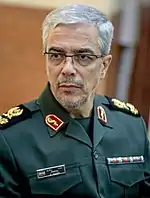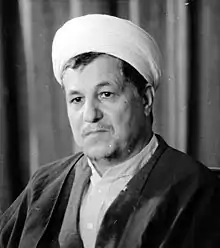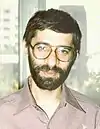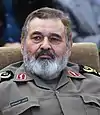General Staff of the Armed Forces of the Islamic Republic of Iran
General Staff of the Armed Forces of the Islamic Republic of Iran (Persian: ستاد کل نیروهای مسلح جمهوری اسلامی ایران) is the most senior military body in Iran, with an aim to implement policy, monitor and coordinate activities within the Armed Forces.[5]
| Chief of the General Staff of the Armed Forces of the Islamic Republic of Iran
ستاد کل نیروهای مسلح جمهوری اسلامی ایران | |
|---|---|
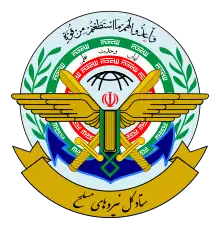 Seal of the General Staff of the Armed Forces | |
 Flag of the General Staff of the Armed Forces | |
| Armed Forces of Iran | |
| Type | Chief of the General Staff |
| Status | Active |
| Reports to | Military office of the Supreme Leader[1] |
| Appointer | Supreme Leader of Iran |
| Term length | No fixed length |
| Formation | June 1988[2][3][4] |
| First holder | Hassan Firouzabadi |
| Deputy | Brigadier general Mohammadreza Gharaei Ashtiani |
Iran's two existing separate militaries, the Islamic Republic of Iran Army (Arteš) and the Islamic Revolutionary Guard Corps (Sepāh) are formally subordinate to the general staff; as well as Iran's sole national police force, the Law Enforcement Force.[5]
The organization was set up in 1989 in order to enhance cooperation and counterbalance the rivalry between the armed forces and is directly decreed by Supreme Leader of Iran, while the Ministry of Defence and Armed Forces Logistics, responsible for planning, logistics and funding of the armed forces is part of the executive branch under President of Iran.[5]
List of Chiefs
| No. | Portrait | Chief | Took office | Left office | Time in office | Defence branch | Deputies | Ref |
|---|---|---|---|---|---|---|---|---|
| Chief of the Headquarters of the General Command of Forces | ||||||||
| – | Akbar Hashemi Rafsanjani (1934–2017) Acting | July 1988 | 1988 | 0 years | none | none | - | |
| 1 | Mir-Hossein Mousavi (born 1942) | 1988 | 1989 | 0–1 years | none | Hassan Firouzabadi (1988–1989) | - | |
| Chief of the General Staff of the Armed Forces | ||||||||
| 1 | Major general Hassan Firouzabadi (born 1951) | 26 September 1989 | 28 June 2016 | 26 years, 276 days | Basij | Mohammad Forouzandeh (1989–1993) Ali Sayad Shirazi (1993–1999) Gholam Ali Rashid (1999–2016) | – | |
| 2 | Major general Mohammad Bagheri (born c. 1960) | 28 June 2016 | Incumbent | 4 years, 216 days | IRGC | Abdolrahim Mousavi (2016–2017) Ataollah Salehi (2017–2019) Mohammadreza Gharaei (2019–) | – | |
See also
References
- Rouhi, Mahsa (2013). "Iran". In Hassner, Ron E. (ed.). Religion in the Military Worldwide. Cambridge: Cambridge University Press. p. 153. ISBN 1-107-51255-7.
- Cordesman, Anthony H. (1999). Iran's Military Forces in Transition: Conventional Threats and Weapons of Mass Destruction. Westport, Connecticut: Praeger Publishers. p. 276. ISBN 0-275-96529-5.
- Byman, Daniel; Chubin, Shahram; Ehteshami, Anoushiravan; Green, Jerrold D., eds. (2001). Iran's Security Policy in the Post-Revolutionary Era. Santa Monica, CA: RAND Corporation. p. 36. ISBN 0-8330-2971-1. JSTOR 10.7249/mr1320osd.2. MR-1320-OSD.
- Eisenstadt, Michael (2002). "The Armed Forces of the Islamic Republic of Iran: An Assessment". In Rubin, Barry; Keaney, Thomas A. (eds.). Armed Forces in the Middle East: Politics and Strategy. Abingdon, Oxon: Frank Cass Publishers. p. 240. ISBN 0-7146-8245-4.
- Forozan, Hesam (2016). The Military in Post-Revolutionary Iran: The Evolution and Roles of the Revolutionary Guards. Abingdon, Oxon: Routledge. pp. 51–53. ISBN 978-1-138-91302-8.
